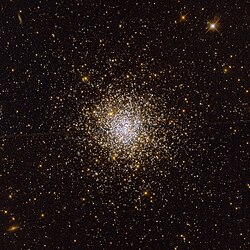Astronomy:NGC 1868
From HandWiki
Short description: Globular cluster in the constellation Dorado
| NGC 1868 | |
|---|---|
 Photograph of NGC 1868 taken by the Hubble Space Telescope | |
| Observation data (J2000 epoch) | |
| Constellation | Dorado |
| Right ascension | 05h 14m 36s[1] |
| Declination | −63° 57′ 18″[1] |
| Distance | ~163000 ly (~50000 pc) |
| Apparent magnitude (V) | 11.57[1] |
| Apparent dimensions (V) | 2.7' × 2.7'[1] |
| Physical characteristics | |
| Other designations | NGC 1868, ESO 85-56, KMHK 674, LW 169[1] |
NGC 1868 is a globular cluster in the Large Magellanic Cloud in the constellation Dorado.[2] It was discovered by John Herschel in 1834.[2] The cluster is fairly metal-poor and as a result appears relatively blue. It maintains an abundant population of mature giant branch stars which have been used to fit its age to roughly 700 million years old.[3] The cluster is located in a relatively sparse region of the Large Magellanic Cloud which has allowed it to be studied relatively free of crowding from background stars.[3]
References
- ↑ 1.0 1.1 1.2 1.3 1.4 "NGC 1868". SIMBAD. Centre de données astronomiques de Strasbourg. http://simbad.u-strasbg.fr/simbad/sim-basic?Ident=NGC+1868.
- ↑ 2.0 2.1 Seligman, Courtney. "Celestial Atlas: NGC Objects: NGC 1850 - 1899". http://cseligman.com/text/atlas/ngc18a.htm.
- ↑ 3.0 3.1 "1980ApJ...235..769F Page 769". https://adsabs.harvard.edu/full/1980ApJ...235..769F.
External links
- SIMBAD
- NASA/IPAC
- Flower, P. J., Geisler, D., Olszewski, E. W., & Hodge, P.: NGC 1868 - A metal-poor intermediate-age cluster in the Large Magellanic Cloud, 1980ApJ...235..769F
 |

